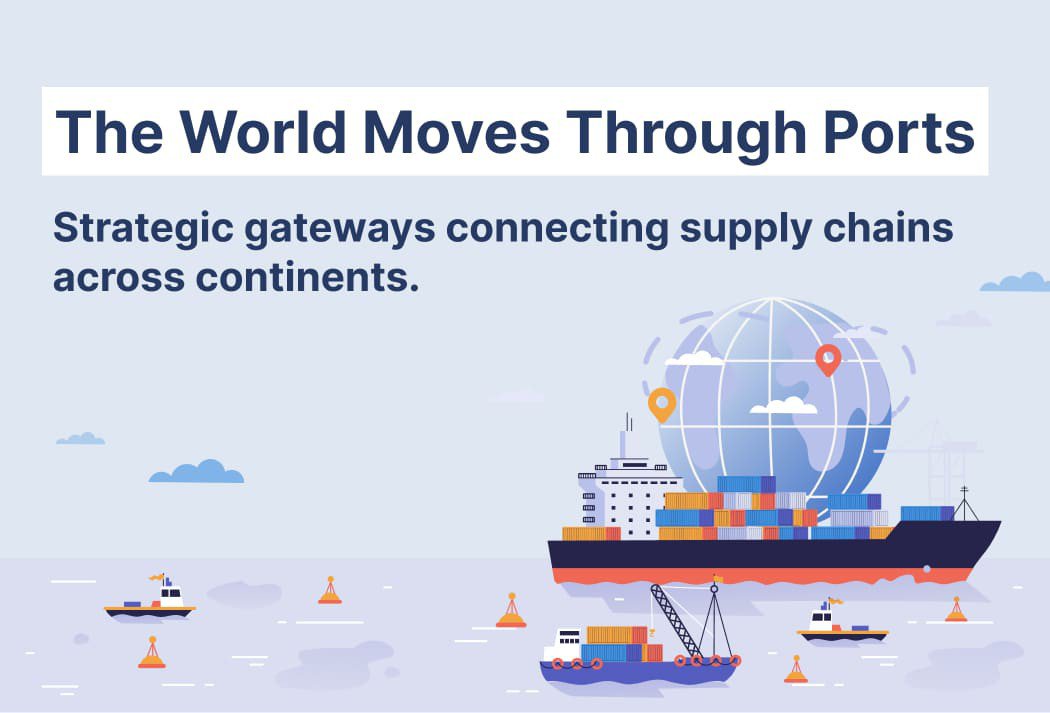
In today’s connected world, international trade keeps the global economy running. Every product we use—like smartphones, cars, clothes, or even a cup of coffee—comes to us through a complex supply chain. And at the center of these supply chains are seaports.
From the huge cranes in Shanghai to the busy docks in Los Angeles, ports play a key role in moving goods around the world. They are important links that help products travel from one country to another. In this article, we’ll look at why ports matter, why they are important for trade, and how they continue to shape the way the world does business.
The Role of Global Ports in Modern Logistics
Ports are more than just places where big ships stop. They are busy, organized areas that help move goods from one part of the world to another. These ports connect people—like farmers, factory owners, and shopkeepers—across different countries.
Not all goods are the same. Some come in containers, others like coal or grain are shipped in bulk, and things like oil or chemicals need special tanks. Ports are built to handle each of these in different ways. When a port works well, it helps save time and money and makes sure goods move smoothly from ships to trucks or trains.
Most of the things we buy or use—over 80% by volume—travel by sea, as noted by UNCTAD. That’s why ports are so important. They’re not just places for loading and unloading—they help countries trade better and grow their economies.
Port of Shanghai, Port of Hamburg, and Port of Los Angeles: Global Gateways
Let’s take a closer look at three iconic ports that exemplify global trade leadership:
Port of Shanghai (China)
As the world’s busiest container port, the Port of Shanghai has been a critical player in facilitating China’s export-driven economy. Handling over 47 million TEUs (twenty-foot equivalent units) annually, it serves as a crucial gateway for trade routes connecting East Asia to Europe, North America, and beyond.
Located at the mouth of the Yangtze River, Shanghai benefits from both deep-sea access and proximity to China’s major industrial zones. Its state-of-the-art automated terminals and integrated logistics parks allow it to efficiently manage high volumes of containerized and bulk cargo.
Port of Hamburg (Germany)
Often dubbed “Germany’s Gateway to the World,” the Port of Hamburg is one of Europe’s busiest ports, handling around 8 to 9 million TEUs annually. Strategically located on the Elbe River, it offers direct access to key markets in Central and Eastern Europe.
Apart from being a major container hub, Hamburg is a leader in handling project cargo, breakbulk, and automotive logistics. Its strong rail connections make it a model example of a port seamlessly integrated with hinterland transport infrastructure.
Port of Los Angeles (USA)
As the busiest port in the United States, the Port of Los Angeles is the principal gateway for trans-Pacific trade. Alongside the adjacent Port of Long Beach, it handles over 19 million TEUs combined.
Its proximity to major consumer markets like California and the American Midwest, coupled with advanced container handling facilities and intermodal rail services, makes it vital for US imports, especially from Asian economies.
Factors That Define a Port’s Strategic Value
Not every port can be a Shanghai or a Los Angeles. What elevates a port to global significance involves a mix of natural, geographic, economic, and operational factors:
Geographical Location
Ports located along major shipping routes like the Suez Canal, Strait of Malacca, or Panama Canal naturally attract higher traffic due to convenience and cost-efficiency.
Natural Deep-Water Access
The ability to accommodate large vessels (like ultra-large container ships) is crucial, especially as global trade trends toward higher capacity ships for economies of scale.
Connectivity to Hinterlands
Efficient rail, road, and inland waterway links to industrial and consumption hubs determine how quickly and cost-effectively goods can move inland.
Port Infrastructure and Technology
Modern container terminals, specialized handling equipment, and digitalized logistics platforms improve cargo throughput, reduce dwell time, and optimize vessel turnaround.
Regulatory Environment and Customs Efficiency
Ports operating under transparent, efficient customs procedures and trade-friendly policies attract higher trade volumes due to predictable clearance and reduced delays.
Resilience and Security
Ports that can quickly recover from disruptions (like COVID-19, geopolitical tensions, or natural disasters) while ensuring cargo security rank higher in strategic importance.
Enhancing Trade Efficiency Through Port Operations
The efficiency of port operations directly affects international supply chains. Here’s how leading ports enhance trade performance:
Adoption of Smart Port Technologies
Automation, AI-driven logistics platforms, and IoT-based cargo tracking systems are transforming ports into data-driven, intelligent logistics hubs. For example, the Port of Rotterdam uses digital twin technology to simulate terminal operations and improve decision-making.
Green Port Initiatives
Sustainability has become a core focus, with ports investing in shore power systems, eco-friendly terminal equipment, and cleaner fuels for ships to reduce carbon emissions. The Port of Los Angeles has led several green initiatives, including zero-emission cargo handling equipment.
Collaborative Trade Partnerships
Strategic alliances between ports, carriers, and logistics providers ensure streamlined operations. Programs like the World Ports Sustainability Program (WPSP) encourage ports worldwide to share best practices in sustainable and efficient port management.
Infrastructure Expansion Projects
Major ports consistently invest in upgrading their capacities. The Port of Shanghai’s Yangshan Deep-Water Port expansion and the Port of Los Angeles’ infrastructure modernization programs are prime examples of future-proofing facilities for growing trade volumes.
Looking Ahead: The Evolving Role of Ports
Global trade is changing because of new challenges like climate rules, political tensions, and fast-moving technology. Ports now have to do more than just move goods—they need to be smart, flexible, and eco-friendly.
To keep up, ports must find the right balance: working fast and efficiently, staying secure, using clean methods, and staying connected through digital tools. Also, as more companies bring their supply chains closer to home, trade routes will shift. This means ports will need to adjust and work better with roads, railways, and other transport systems.
Conclusion
Big ports like Shanghai, Hamburg, and Los Angeles aren’t just places where ships stop. They are important parts of global trade that help goods move smoothly from one country to another. These ports offer smart and well-connected systems that keep international business running without delays.
As global trade changes, ports also need to improve. The ports that grow with better technology, stronger infrastructure, eco-friendly practices, and teamwork will stay ahead. These modern ports will shape how trade works around the world in the future.





 Get instant quote
and compare offers in real time
Get instant quote
and compare offers in real time